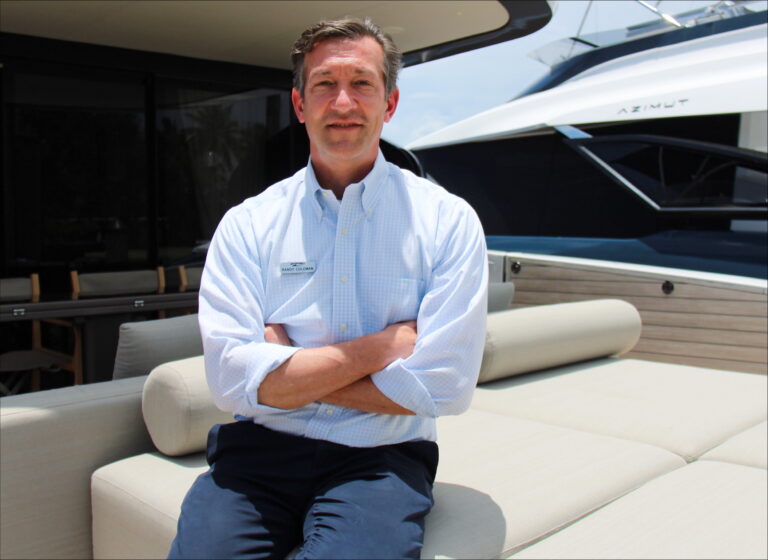In 1994, Jim Dorris, the founder and CEO of PlayCraft Boats, installed a 350-hp MerCruiser sterndrive in a 26-foot pontoon boat. It had through-hull exhaust, and he entered it in what was then called the Shooters 21 Shootout in Lake of the Ozarks, Mo. He ran a speed of 41 knots down the 1-mile course.

“A few people chuckled at the idea of a pontoon running in the shootout,” he recalls. “But we ended up on the front page of the local paper, and the guy who won the [overall] shootout was on page two.”
Fast forward to 2015, when Brad Rowland set the speed record for a pontoon boat in the same event, now known as the Lake of the Ozarks Shootout. He ran 99 knots in a 25-foot South Bay pontoon boat, powered by triple Mercury Racing Pro Max 300X outboards.
That mark still stands for the pontoon-boat class, but now the competition in the category is heating up well beyond the Shootout. The popularity of high-performance pontoon boats is booming. Manufacturers are offering twin 400- and 450-hp outboards on triple-pontoon designs created to run at speeds pushing 70 knots. The players include Barletta, Avalon, Premier and Bennington, among others.

The Family Plan
With Dorris at the helm, PlayCraft has been in business 47 years. The company is based in Richland, Mo., and custom-builds its pontoons, including with single- and twin-stepped bottoms. Dorris says a single step provides a speed increase of up to 2½ knots, while a twin-stepped design adds up to 4.3 knots.
One thing that sets PlayCraft apart is the shape of its pontoons. While most pontoons are rounded, PlayCraft’s pontoons have more of a U-shape. The standard pontoon has a 20-inch diameter and is 24 inches tall, with steps up to a maximum of 28 by 36 inches. PlayCraft also has what it calls Rac-R-Fins and X-treme a surface-piercing “nose” on each pontoon.
Dorris isn’t giving away any other secrets, but he says PlayCraft boats are built for durability on waterways known for rough conditions, including Lake Havasu in Arizona, Lake Conroe in Texas and the company’s home waters of Lake of the Ozarks. He uses different gauges of aluminum based on the application. “If it’s a twin 450, I’m going to use the heavier stuff,” Dorris says. “We apply it to where we know the stress points are.” The deck is pressure-treated marine plywood that is custom-made in a 28-by-8½-foot sheet, so it comes in one piece and doesn’t have seams.
PlayCraft’s alpha dog is its Powertoon X-Treme series with single and twin Mercury Racing 450R outboards. Dorris says PlayCraft is getting more requests for joysticks and other driver-assisting technology.

The Conglomerate
While PlayCraft is family-run, Forest River Marine in Middlebury, Ind., is backed financially by Berkshire Hathaway and builds 4,000 boats a year under three brands: South Bay, Trifecta and Berkshire. Jordan Kistler, product manager for Forest River, says the Trifectas have become one of the best-selling twin Mercury 450R-powered pontoons on the market because of aggressive promotion by dealer Horizon Motorsports in Lake Havasu City, Ariz.
In the past few years, he says, the dealership has sold as many as 45 Trifectas with twin outboards from 700 to 900 hp total. “Twin 450Rs on a stock Trifecta run 80 to 83 mph, and the guys start playing with them at 85 to 86 mph,” Kistler says.
The bottom design for triple pontoon boats is the same among the three Forest River brands. All three pontoons are 25 inches in diameter and have lifting strakes. They are all at the same height and have a full aluminum under-sheeting. The company found that a single-piece solid keel aided performance because it helped the boats track straighter. Trifecta recently started offering Atlas jack plates on its boats.
Forest River points to its composite deck as a key performance element because it weighs 40 percent less than pressure-treated marine plywood and is twice as strong. As with the design, the construction pross is the same across all three brands.
South Bay remains the company’s most popular brand, accounting for nearly 60 percent of annual sales. At the time of this writing, the company was 12 months out on its high-end sport models, with triple-pontoon boats powered by twin outboards (rated at more than 350 hp) comprising 10 percent of those sales.

The Specialist
Manitou Boats in Lansing, Mich., is owned by Bombardier Recreational Products and known for luxury-performance pontoon boats. “Since 2005, when we introduced the SHP [Sport Handling Package], we’ve always sold more triple-tube boats than twin-tube, but we’ve seen rapid growth in the push for high horsepower in the last three to five years,” says Garrett Koschak, manager of global product strategy for Manitou.
With the Sport Handling Package, the center pontoon is 5¼ inches deeper in the water. It also has a 27-inch diameter, while the outer tubes come standard at 23 inches with the option to upgrade to 25 inches apiece.
“If you look at the boat straight on from the bow, the hull actually shapes a V,” Koschak says. The idea is that having the center pontoon deeper in the water creates a running surface that naturally leans into a turn like a vee-bottom. Another Manitou signature element is the “Barracuda nose cone,” which deflects waves and protects the pontoons during bumps with the dock.
Manitou was first issued a patent on the bottom design in May 2011. The company has boats powered by twin 450Rs running into the 70-mph range, and the most popular models are powered by twin 300-hp Mercury Verados. Manitou offers joystick piloting and auto-trim, among other features.

Construction-wise, the company uses staggered equidistant cross members to support the pressure-treated marine plywood decks. Welded side keels also add structural support.
Koschak estimates that triple pontoons make up 65 percent of Manitou’s sales. He says Manitou is building “well north of 2,000 boats for 2021.”
Looking forward, Koschak says, “Manufacturers are realizing that consumers want as much as they can get out of a boat,” he says. “This notion of fast, comfortable pontoon boats is going to be something that becomes more of a norm.”
This article was originally published in the December 2021 issue.











